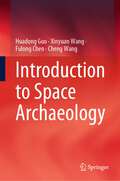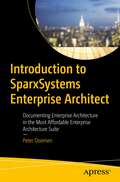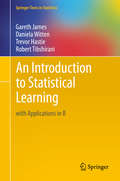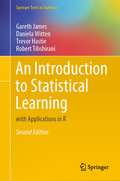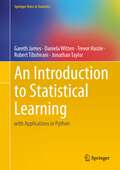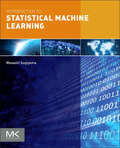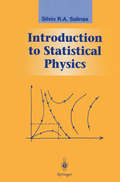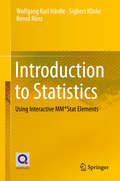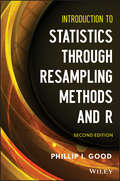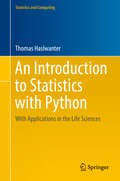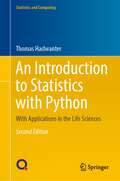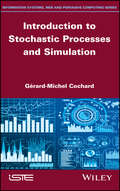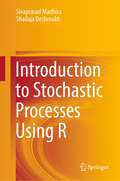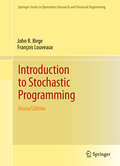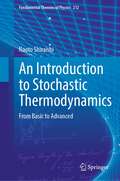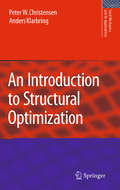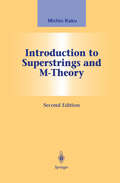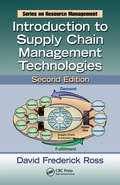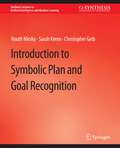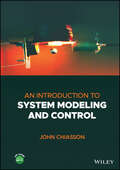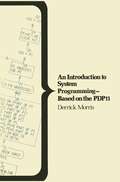- Table View
- List View
Introduction To Solidworks Flow Simulation 2013 (PDF)
by John MatssonAn Introduction to SolidWorks Flow Simulation 2013 takes you through the steps of creating the SolidWorks part for the simulation followed by the setup and calculation of the SolidWorks Flow Simulation project. The results from calculations are visualized and compared with theoretical solutions and empirical data. Each chapter starts with the objectives and a description of the specific problems that are studied. End of chapter exercises are included for reinforcement and practice of what has been learned. The fourteen chapters of this book are directed towards first-time to intermediate level users of SolidWorks Flow Simulation. It is intended to be a supplement to undergraduate Fluid Mechanics and Heat Transfer related courses. This book can also be used to show students the capabilities of fluid flow and heat transfer simulations in freshman and sophomore courses such as Introduction to Engineering. Both internal and external flow problems are covered and compared with experimental results and analytical solutions. Covered topics include airfoil flow, boundary layers, flow meters, heat exchanger, natural and forced convection, pipe flow, rotating flow, tube bank flow and valve flow.
Introduction to Space Archaeology
by Huadong Guo Xinyuan Wang Fulong Chen Cheng WangThis book presents the basic principles and the latest advances in space archaeology. Following general reviews of the state of the art of Earth observation technologies and archaeology, the book introduces the principles and methods of space archaeology, remote sensing methods for archaeological survey, and integrated archaeological survey methods including geophysics, virtual reality, web technologies, global positioning systems (GPS), geographical information systems (GIS), and big data. The book then presents two chapters on case studies of word heritage sites in Asia, Europe, Africa, and Americas, including three major world heritage sites in China: The Great Wall, Grand Canal, and Silk Road. The last chapter of the book discusses the future of space archaeology. This book has an interdisciplinary appeal and scholars with an interest in cultural heritage and remote sensing technologies for Earth value its contribution.
Introduction to SparxSystems Enterprise Architect: Documenting Enterprise Architecture in the Most Affordable Enterprise Architecture Suite
by Peter DoomenSparxSystems Enterprise Architect (EA) is a logical choice for many companies and organizations: it combines a broad feature set with an affordable price. However, the robust range of features makes starting to use this fantastic tool a bit intimidating. Enter Michael, a fictional consultant and experienced enterprise architect featured throughout the book to show you how to populate a model with elements and connectors, and how to create diagrams that speak to the audience: management, project managers, internal audit, business stakeholders and IT representatives. As the book progresses Michael's duties continue with more advanced topics including the use of workflow tools such as Kanban boards. You'll even see how to present directly from Enterprise Architect so that latest information can be shown straight from the source! The last days of Michael’s mission are devoted to fine-tuning the enterprise architecture model with the help of tagged values. And to leave the model in the hands of the customer by creating a custom toolbox. What You'll Learn Setup EA and populate a model with elements, connectors and diagramsReview the Big Five of enterprise architect: Model, Packages, Diagrams, Elements, ConnectorsImplement evidence-based best practice strategies aligned with overall goalsWho This Book Is ForNon-technical users who use EA mainly to document entire landscapes.
An Introduction to Statistical Learning: with Applications in R (Springer Texts in Statistics #103)
by Gareth James Daniela Witten Trevor Hastie Robert TibshiraniAn Introduction to Statistical Learning provides an accessible overview of the field of statistical learning, an essential toolset for making sense of the vast and complex data sets that have emerged in fields ranging from biology to finance to marketing to astrophysics in the past twenty years. This book presents some of the most important modeling and prediction techniques, along with relevant applications. Topics include linear regression, classification, resampling methods, shrinkage approaches, tree-based methods, support vector machines, clustering, and more. Color graphics and real-world examples are used to illustrate the methods presented. Since the goal of this textbook is to facilitate the use of these statistical learning techniques by practitioners in science, industry, and other fields, each chapter contains a tutorial on implementing the analyses and methods presented in R, an extremely popular open source statistical software platform.Two of the authors co-wrote The Elements of Statistical Learning (Hastie, Tibshirani and Friedman, 2nd edition 2009), a popular reference book for statistics and machine learning researchers. An Introduction to Statistical Learning covers many of the same topics, but at a level accessible to a much broader audience. This book is targeted at statisticians and non-statisticians alike who wish to use cutting-edge statistical learning techniques to analyze their data. The text assumes only a previous course in linear regression and no knowledge of matrix algebra.
An Introduction to Statistical Learning: with Applications in R (Springer Texts in Statistics)
by Gareth James Daniela Witten Trevor Hastie Robert TibshiraniAn Introduction to Statistical Learning provides an accessible overview of the field of statistical learning, an essential toolset for making sense of the vast and complex data sets that have emerged in fields ranging from biology to finance to marketing to astrophysics in the past twenty years. This book presents some of the most important modeling and prediction techniques, along with relevant applications. Topics include linear regression, classification, resampling methods, shrinkage approaches, tree-based methods, support vector machines, clustering, deep learning, survival analysis, multiple testing, and more. Color graphics and real-world examples are used to illustrate the methods presented. Since the goal of this textbook is to facilitate the use of these statistical learning techniques by practitioners in science, industry, and other fields, each chapter contains a tutorial on implementing the analyses and methods presented in R, an extremely popular open source statistical software platform.Two of the authors co-wrote The Elements of Statistical Learning (Hastie, Tibshirani and Friedman, 2nd edition 2009), a popular reference book for statistics and machine learning researchers. An Introduction to Statistical Learning covers many of the same topics, but at a level accessible to a much broader audience. This book is targeted at statisticians and non-statisticians alike who wish to use cutting-edge statistical learning techniques to analyze their data. The text assumes only a previous course in linear regression and no knowledge of matrix algebra.This Second Edition features new chapters on deep learning, survival analysis, and multiple testing, as well as expanded treatments of naïve Bayes, generalized linear models, Bayesian additive regression trees, and matrix completion. R code has been updated throughout to ensure compatibility.
An Introduction to Statistical Learning: with Applications in Python (Springer Texts in Statistics)
by Gareth James Daniela Witten Trevor Hastie Robert Tibshirani Jonathan TaylorAn Introduction to Statistical Learning provides an accessible overview of the field of statistical learning, an essential toolset for making sense of the vast and complex data sets that have emerged in fields ranging from biology to finance, marketing, and astrophysics in the past twenty years. This book presents some of the most important modeling and prediction techniques, along with relevant applications. Topics include linear regression, classification, resampling methods, shrinkage approaches, tree-based methods, support vector machines, clustering, deep learning, survival analysis, multiple testing, and more. Color graphics and real-world examples are used to illustrate the methods presented. This book is targeted at statisticians and non-statisticians alike, who wish to use cutting-edge statistical learning techniques to analyze their data. Four of the authors co-wrote An Introduction to Statistical Learning, With Applications in R (ISLR), which has become a mainstay of undergraduate and graduate classrooms worldwide, as well as an important reference book for data scientists. One of the keys to its success was that each chapter contains a tutorial on implementing the analyses and methods presented in the R scientific computing environment. However, in recent years Python has become a popular language for data science, and there has been increasing demand for a Python-based alternative to ISLR. Hence, this book (ISLP) covers the same materials as ISLR but with labs implemented in Python. These labs will be useful both for Python novices, as well as experienced users.
Introduction to Statistical Machine Learning
by Masashi SugiyamaMachine learning allows computers to learn and discern patterns without actually being programmed. When Statistical techniques and machine learning are combined together they are a powerful tool for analysing various kinds of data in many computer science/engineering areas including, image processing, speech processing, natural language processing, robot control, as well as in fundamental sciences such as biology, medicine, astronomy, physics, and materials. Introduction to Statistical Machine Learning provides a general introduction to machine learning that covers a wide range of topics concisely and will help you bridge the gap between theory and practice. Part I discusses the fundamental concepts of statistics and probability that are used in describing machine learning algorithms. Part II and Part III explain the two major approaches of machine learning techniques; generative methods and discriminative methods. While Part III provides an in-depth look at advanced topics that play essential roles in making machine learning algorithms more useful in practice. The accompanying MATLAB/Octave programs provide you with the necessary practical skills needed to accomplish a wide range of data analysis tasks.Provides the necessary background material to understand machine learning such as statistics, probability, linear algebra, and calculusComplete coverage of the generative approach to statistical pattern recognition and the discriminative approach to statistical machine learningIncludes MATLAB/Octave programs so that readers can test the algorithms numerically and acquire both mathematical and practical skills in a wide range of data analysis tasksDiscusses a wide range of applications in machine learning and statistics and provides examples drawn from image processing, speech processing, natural language processing, robot control, as well as biology, medicine, astronomy, physics, and materials
Introduction to Statistical Physics (Graduate Texts in Contemporary Physics)
by Silvio SalinasThis textbook covers the basic principles of statistical physics and thermodynamics. The text is pitched at the level equivalent to first-year graduate studies or advanced undergraduate studies. It presents the subject in a straightforward and lively manner. After reviewing the basic probability theory of classical thermodynamics, the author addresses the standard topics of statistical physics. The text demonstrates their relevance in other scientific fields using clear and explicit examples. Later chapters introduce phase transitions, critical phenomena and non-equilibrium phenomena.
Introduction to Statistics: Using Interactive MM*Stat Elements
by Wolfgang Karl Härdle Sigbert Klinke Bernd RönzThis book covers all the topics found in introductory descriptive statistics courses, including simple linear regression and time series analysis, the fundamentals of inferential statistics (probability theory, random sampling and estimation theory), and inferential statistics itself (confidence intervals, testing).Each chapter starts with the necessary theoretical background, which is followed by a variety of examples. The core examples are based on the content of the respective chapter, while the advanced examples, designed to deepen students’ knowledge, also draw on information and material from previous chapters.The enhanced online version helps students grasp the complexity and the practical relevance of statistical analysis through interactive examples and is suitable for undergraduate and graduate students taking their first statistics courses, as well as for undergraduate students in non-mathematical fields, e.g. economics, the social sciences etc.
Introduction to Statistics Through Resampling Methods and R
by Phillip I. GoodA highly accessible alternative approach to basic statistics Praise for the First Edition: "Certainly one of the most impressive little paperback 200-page introductory statistics books that I will ever see . . . it would make a good nightstand book for every statistician."—Technometrics Written in a highly accessible style, Introduction to Statistics through Resampling Methods and R, Second Edition guides students in the understanding of descriptive statistics, estimation, hypothesis testing, and model building. The book emphasizes the discovery method, enabling readers to ascertain solutions on their own rather than simply copy answers or apply a formula by rote. The Second Edition utilizes the R programming language to simplify tedious computations, illustrate new concepts, and assist readers in completing exercises. The text facilitates quick learning through the use of: More than 250 exercises—with selected "hints"—scattered throughout to stimulate readers' thinking and to actively engage them in applying their newfound skills An increased focus on why a method is introduced Multiple explanations of basic concepts Real-life applications in a variety of disciplines Dozens of thought-provoking, problem-solving questions in the final chapter to assist readers in applying statistics to real-life applications Introduction to Statistics through Resampling Methods and R, Second Edition is an excellent resource for students and practitioners in the fields of agriculture, astrophysics, bacteriology, biology, botany, business, climatology, clinical trials, economics, education, epidemiology, genetics, geology, growth processes, hospital administration, law, manufacturing, marketing, medicine, mycology, physics, political science, psychology, social welfare, sports, and toxicology who want to master and learn to apply statistical methods.
Introduction to Statistics Through Resampling Methods and R
by Phillip I. GoodA highly accessible alternative approach to basic statistics Praise for the First Edition: "Certainly one of the most impressive little paperback 200-page introductory statistics books that I will ever see . . . it would make a good nightstand book for every statistician."—Technometrics Written in a highly accessible style, Introduction to Statistics through Resampling Methods and R, Second Edition guides students in the understanding of descriptive statistics, estimation, hypothesis testing, and model building. The book emphasizes the discovery method, enabling readers to ascertain solutions on their own rather than simply copy answers or apply a formula by rote. The Second Edition utilizes the R programming language to simplify tedious computations, illustrate new concepts, and assist readers in completing exercises. The text facilitates quick learning through the use of: More than 250 exercises—with selected "hints"—scattered throughout to stimulate readers' thinking and to actively engage them in applying their newfound skills An increased focus on why a method is introduced Multiple explanations of basic concepts Real-life applications in a variety of disciplines Dozens of thought-provoking, problem-solving questions in the final chapter to assist readers in applying statistics to real-life applications Introduction to Statistics through Resampling Methods and R, Second Edition is an excellent resource for students and practitioners in the fields of agriculture, astrophysics, bacteriology, biology, botany, business, climatology, clinical trials, economics, education, epidemiology, genetics, geology, growth processes, hospital administration, law, manufacturing, marketing, medicine, mycology, physics, political science, psychology, social welfare, sports, and toxicology who want to master and learn to apply statistical methods.
An Introduction to Statistics with Python: With Applications in the Life Sciences (Statistics and Computing)
by Thomas HaslwanterThis textbook provides an introduction to the free software Python and its use for statistical data analysis. It covers common statistical tests for continuous, discrete and categorical data, as well as linear regression analysis and topics from survival analysis and Bayesian statistics. Working code and data for Python solutions for each test, together with easy-to-follow Python examples, can be reproduced by the reader and reinforce their immediate understanding of the topic. With recent advances in the Python ecosystem, Python has become a popular language for scientific computing, offering a powerful environment for statistical data analysis and an interesting alternative to R. The book is intended for master and PhD students, mainly from the life and medical sciences, with a basic knowledge of statistics. As it also provides some statistics background, the book can be used by anyone who wants to perform a statistical data analysis.
An Introduction to Statistics with Python: With Applications in the Life Sciences (Statistics and Computing)
by Thomas HaslwanterNow in its second edition, this textbook provides an introduction to Python and its use for statistical data analysis. It covers common statistical tests for continuous, discrete and categorical data, as well as linear regression analysis and topics from survival analysis and Bayesian statistics.For this new edition, the introductory chapters on Python, data input and visualization have been reworked and updated. The chapter on experimental design has been expanded, and programs for the determination of confidence intervals commonly used in quality control have been introduced. The book also features a new chapter on finding patterns in data, including time series. A new appendix describes useful programming tools, such as testing tools, code repositories, and GUIs.The provided working code for Python solutions, together with easy-to-follow examples, will reinforce the reader’s immediate understanding of the topic. Accompanying data sets and Python programs are also available online. With recent advances in the Python ecosystem, Python has become a popular language for scientific computing, offering a powerful environment for statistical data analysis.With examples drawn mainly from the life and medical sciences, this book is intended primarily for masters and PhD students. As it provides the required statistics background, the book can also be used by anyone who wants to perform a statistical data analysis.
Introduction to Stochastic Processes and Simulation
by Gerard-Michel CochardMastering chance has, for a long time, been a preoccupation of mathematical research. Today, we possess a predictive approach to the evolution of systems based on the theory of probabilities. Even so, uncovering this subject is sometimes complex, because it necessitates a good knowledge of the underlying mathematics. This book offers an introduction to the processes linked to the fluctuations in chance and the use of numerical methods to approach solutions that are difficult to obtain through an analytical approach. It takes classic examples of inventory and queueing management, and addresses more diverse subjects such as equipment reliability, genetics, population dynamics, physics and even market finance. It is addressed to those at Master's level, at university, engineering school or management school, but also to an audience of those in continuing education, in order that they may discover the vast field of decision support.
Introduction to Stochastic Processes and Simulation
by Gerard-Michel CochardMastering chance has, for a long time, been a preoccupation of mathematical research. Today, we possess a predictive approach to the evolution of systems based on the theory of probabilities. Even so, uncovering this subject is sometimes complex, because it necessitates a good knowledge of the underlying mathematics. This book offers an introduction to the processes linked to the fluctuations in chance and the use of numerical methods to approach solutions that are difficult to obtain through an analytical approach. It takes classic examples of inventory and queueing management, and addresses more diverse subjects such as equipment reliability, genetics, population dynamics, physics and even market finance. It is addressed to those at Master's level, at university, engineering school or management school, but also to an audience of those in continuing education, in order that they may discover the vast field of decision support.
Introduction to Stochastic Processes Using R
by Sivaprasad Madhira Shailaja DeshmukhThis textbook presents some basic stochastic processes, mainly Markov processes. It begins with a brief introduction to the framework of stochastic processes followed by the thorough discussion on Markov chains, which is the simplest and the most important class of stochastic processes. The book then elaborates the theory of Markov chains in detail including classification of states, the first passage distribution, the concept of periodicity and the limiting behaviour of a Markov chain in terms of associated stationary and long run distributions. The book first illustrates the theory for some typical Markov chains, such as random walk, gambler's ruin problem, Ehrenfest model and Bienayme-Galton-Watson branching process; and then extends the discussion when time parameter is continuous. It presents some important examples of a continuous time Markov chain, which include Poisson process, birth process, death process, birth and death processes and their variations. These processes play a fundamental role in the theory and applications in queuing and inventory models, population growth, epidemiology and engineering systems. The book studies in detail the Poisson process, which is the most frequently applied stochastic process in a variety of fields, with its extension to a renewal process. The book also presents important basic concepts on Brownian motion process, a stochastic process of historic importance. It covers its few extensions and variations, such as Brownian bridge, geometric Brownian motion process, which have applications in finance, stock markets, inventory etc. The book is designed primarily to serve as a textbook for a one semester introductory course in stochastic processes, in a post-graduate program, such as Statistics, Mathematics, Data Science and Finance. It can also be used for relevant courses in other disciplines. Additionally, it provides sufficient background material for studying inference in stochastic processes. The book thus fulfils the need of a concise but clear and student-friendly introduction to various types of stochastic processes.
Introduction to Stochastic Programming (Springer Series in Operations Research and Financial Engineering)
by John R. Birge François LouveauxThe aim of stochastic programming is to find optimal decisions in problems which involve uncertain data. This field is currently developing rapidly with contributions from many disciplines including operations research, mathematics, and probability. At the same time, it is now being applied in a wide variety of subjects ranging from agriculture to financial planning and from industrial engineering to computer networks. This textbook provides a first course in stochastic programming suitable for students with a basic knowledge of linear programming, elementary analysis, and probability. The authors aim to present a broad overview of the main themes and methods of the subject. Its prime goal is to help students develop an intuition on how to model uncertainty into mathematical problems, what uncertainty changes bring to the decision process, and what techniques help to manage uncertainty in solving the problems.In this extensively updated new edition there is more material on methods and examples including several new approaches for discrete variables, new results on risk measures in modeling and Monte Carlo sampling methods, a new chapter on relationships to other methods including approximate dynamic programming, robust optimization and online methods.The book is highly illustrated with chapter summaries and many examples and exercises. Students, researchers and practitioners in operations research and the optimization area will find it particularly of interest. Review of First Edition:"The discussion on modeling issues, the large number of examples used to illustrate the material, and the breadth of the coverage make 'Introduction to Stochastic Programming' an ideal textbook for the area." (Interfaces, 1998)
An Introduction to Stochastic Thermodynamics: From Basic to Advanced (Fundamental Theories of Physics #212)
by Naoto ShiraishiThis book presents the fundamentals of stochastic thermodynamics, one of the most central subjects in non-equilibrium statistical mechanics. It also explores many recent advances, e.g., in information thermodynamics, the thermodynamic uncertainty relation, and the trade-off relation between efficiency and power. The content is divided into three main parts, the first of which introduces readers to fundamental topics in stochastic thermodynamics, e.g., the basics of stochastic processes, the fluctuation theorem and its variants, information thermodynamics, and large deviation theory. In turn, parts two and three explore advanced topics such as autonomous engines (engines not controlled externally) and finite speed engines, while also explaining the key concepts from recent stochastic thermodynamics theory that are involved. To fully benefit from the book, readers only need an undergraduate-level background in statistical mechanics and quantum mechanics; no background in information theory or stochastic processes is needed. Accordingly, the book offers a valuable resource for early graduate or higher-level readers who are unfamiliar with this subject but want to keep up with the cutting-edge research in this field. In addition, the author’s vivid descriptions interspersed throughout the book will help readers grasp ‘living’ research developments and begin their own research in this field.
An Introduction to Structural Optimization (Solid Mechanics and Its Applications #153)
by Peter W. Christensen A. KlarbringThis book has grown out of lectures and courses given at Linköping University, Sweden, over a period of 15 years. It gives an introductory treatment of problems and methods of structural optimization. The three basic classes of geometrical - timization problems of mechanical structures, i. e. , size, shape and topology op- mization, are treated. The focus is on concrete numerical solution methods for d- crete and (?nite element) discretized linear elastic structures. The style is explicit and practical: mathematical proofs are provided when arguments can be kept e- mentary but are otherwise only cited, while implementation details are frequently provided. Moreover, since the text has an emphasis on geometrical design problems, where the design is represented by continuously varying—frequently very many— variables, so-called ?rst order methods are central to the treatment. These methods are based on sensitivity analysis, i. e. , on establishing ?rst order derivatives for - jectives and constraints. The classical ?rst order methods that we emphasize are CONLIN and MMA, which are based on explicit, convex and separable appro- mations. It should be remarked that the classical and frequently used so-called op- mality criteria method is also of this kind. It may also be noted in this context that zero order methods such as response surface methods, surrogate models, neural n- works, genetic algorithms, etc. , essentially apply to different types of problems than the ones treated here and should be presented elsewhere.
Introduction to Superstrings and M-Theory (Graduate Texts in Contemporary Physics)
by Michio KakuCalled by some "the theory of everything," superstrings may solve a problem which has eluded physicists for the past 50 years -- the final unification of the two great theories of the twentieth century, general relativity and quantum field theory. This is a course-tested comprehensive introductory graduate text on superstrings which stresses the most current areas of interest, not covered in other presentation, including: string field theory, multi loops, Teichmueller spaces, conformal field theory, and four-dimensional strings. The book begins with a simple discussion of point particle theory, and uses the Feynman path integral technique to unify the presentation of superstrings. Prerequisites are an aquaintance with quantum mechanics and relativity. This second edition has been revised and updated throughout.
Introduction to Supply Chain Management Technologies
by David Frederick Ross Frederick S. Weston Stephen W.It is almost impossible to conceive of the concept and practical application of supply chain management (SCM) without linking it to the enabling power of today‘s information technologies. Building upon the foundations of the first edition, Introduction to Supply Chain Management Technologies, Second Edition details the software toolsets and suites
Introduction to Symbolic Plan and Goal Recognition (Synthesis Lectures on Artificial Intelligence and Machine Learning)
by Reuth Reuth Mirsky Sarah Sarah Keren Christopher Christopher GeibPlan recognition, activity recognition, and goal recognition all involve making inferences about other actors based on observations of their interactions with the environment and other agents. This synergistic area of research combines, unites, and makes use of techniques and research from a wide range of areas including user modeling, machine vision, automated planning, intelligent user interfaces, human-computer interaction, autonomous and multi-agent systems, natural language understanding, and machine learning. It plays a crucial role in a wide variety of applications including assistive technology, software assistants, computer and network security, human-robot collaboration, natural language processing, video games, and many more. This wide range of applications and disciplines has produced a wealth of ideas, models, tools, and results in the recognition literature. However, it has also contributed to fragmentation in the field, with researchers publishing relevant results in a wide spectrum of journals and conferences. This book seeks to address this fragmentation by providing a high-level introduction and historical overview of the plan and goal recognition literature. It provides a description of the core elements that comprise these recognition problems and practical advice for modeling them. In particular, we define and distinguish the different recognition tasks. We formalize the major approaches to modeling these problems using a single motivating example. Finally, we describe a number of state-of-the-art systems and their extensions, future challenges, and some potential applications.
An Introduction to System Modeling and Control
by John ChiassonA practical and straightforward exploration of the basic tools for the modeling, analysis, and design of control systems In An Introduction to System Modeling and Control, Dr. Chiasson delivers an accessible and intuitive guide to understanding modeling and control for students in electrical, mechanical, and aerospace/aeronautical engineering. The book begins with an introduction to the need for control by describing how an aircraft flies complete with figures illustrating roll, pitch, and yaw control using its ailerons, elevators, and rudder, respectively. The book moves on to rigid body dynamics about a single axis (gears, cart rolling down an incline) and then to modeling DC motors, DC tachometers, and optical encoders. Using the transfer function representation of these dynamic models, PID controllers are introduced as an effective way to track step inputs and reject constant disturbances. It is further shown how any transfer function model can be stabilized using output pole placement and on how two-degree of freedom controllers can be used to eliminate overshoot in step responses. Bode and Nyquist theory are then presented with an emphasis on how they give a quantitative insight into a control system's robustness and sensitivity. An Introduction to System Modeling and Control closes with chapters on modeling an inverted pendulum and a magnetic levitation system, trajectory tracking control using state feedback, and state estimation. In addition the book offers: A complete set of MATLAB/SIMULINK files for examples and problems included in the book. A set of lecture slides for each chapter. A solutions manual with recommended problems to assign. An analysis of the robustness and sensitivity of four different controller designs for an inverted pendulum (cart-pole). Perfect for electrical, mechanical, and aerospace/aeronautical engineering students, An Introduction to System Modeling and Control will also be an invaluable addition to the libraries of practicing engineers.
An Introduction to System Modeling and Control
by John ChiassonA practical and straightforward exploration of the basic tools for the modeling, analysis, and design of control systems In An Introduction to System Modeling and Control, Dr. Chiasson delivers an accessible and intuitive guide to understanding modeling and control for students in electrical, mechanical, and aerospace/aeronautical engineering. The book begins with an introduction to the need for control by describing how an aircraft flies complete with figures illustrating roll, pitch, and yaw control using its ailerons, elevators, and rudder, respectively. The book moves on to rigid body dynamics about a single axis (gears, cart rolling down an incline) and then to modeling DC motors, DC tachometers, and optical encoders. Using the transfer function representation of these dynamic models, PID controllers are introduced as an effective way to track step inputs and reject constant disturbances. It is further shown how any transfer function model can be stabilized using output pole placement and on how two-degree of freedom controllers can be used to eliminate overshoot in step responses. Bode and Nyquist theory are then presented with an emphasis on how they give a quantitative insight into a control system's robustness and sensitivity. An Introduction to System Modeling and Control closes with chapters on modeling an inverted pendulum and a magnetic levitation system, trajectory tracking control using state feedback, and state estimation. In addition the book offers: A complete set of MATLAB/SIMULINK files for examples and problems included in the book. A set of lecture slides for each chapter. A solutions manual with recommended problems to assign. An analysis of the robustness and sensitivity of four different controller designs for an inverted pendulum (cart-pole). Perfect for electrical, mechanical, and aerospace/aeronautical engineering students, An Introduction to System Modeling and Control will also be an invaluable addition to the libraries of practicing engineers.

